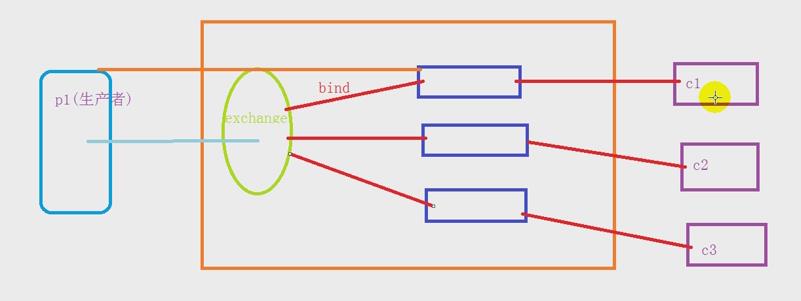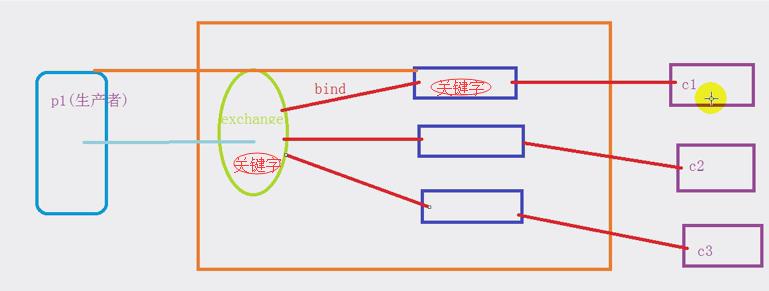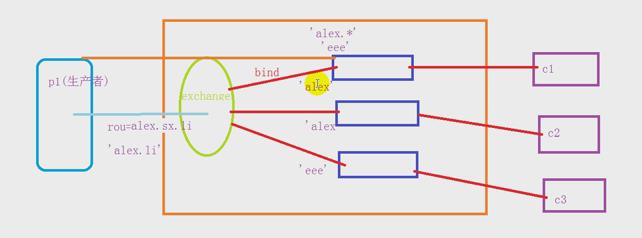RabbitMQ(从安装到使用)
Posted Wyc
tags:
篇首语:本文由小常识网(cha138.com)小编为大家整理,主要介绍了RabbitMQ(从安装到使用)相关的知识,希望对你有一定的参考价值。
RabbitMQ
一,RabbitMQ简单介绍:
RabbitMQ是一个在AMQP基础上完整的,可复用的企业消息系统。他遵循Mozilla Public License开源协议。
MQ全称为Message Queue, 消息队列(MQ)是一种应用程序对应用程序的通信方法。应用程序通过读写出入队列的消息(针对应用程序的数据)来通信,而无需专用连接来链接它们。消 息传递指的是程序之间通过在消息中发送数据进行通信,而不是通过直接调用彼此来通信,直接调用通常是用于诸如远程过程调用的技术。排队指的是应用程序通过 队列来通信。队列的使用除去了接收和发送应用程序同时执行的要求。
二,安装
pip install pika
三,简单队列
1丶使用API操作RabbitMQ
基于Queue实现生产者消费者模型

1 2 3 4 5 6 7 8 9 10 11 12 13 14 15 16 17 18 19 20 21 22 23 24 25 26 #!/usr/bin/env python # -*- coding:utf-8 -*- import Queue import threading message = Queue.Queue(10) def producer(i): while True: message.put(i) def consumer(i): while True: msg = message.get() for i in range(12): t = threading.Thread(target=producer, args=(i,)) t.start() for i in range(10): t = threading.Thread(target=consumer, args=(i,)) t.start()
对于RabbitMQ来说,生产和消费不再针对内存里的一个Queue对象,而是某台服务器上的RabbitMQ Server实现的消息队列。

# !/usr/bin/env python # -*- coding:utf-8 -*- import pika connection = pika.BaseConnection(pika.ConnectionParameters(host=\'10.211.55.4\')) # 封装socket逻辑部分 channel = connection.channel() # 拿到操作句柄 channel.queue_declare(queue=\'hello\') # 通过channel创建一个队列,再给给队列取名字 channel.basic_publish(exchange=\'\', # 通过句柄给 routing_key=\'hello\', # 把body的数据放到名为hello的队列里去 body=\'Hello World!\', )) print("[x] Sent \'Hello World!") connection.close()

# !/usr/bin/env python # -*- coding:utf-8 -*- import pika connection = pika.BaseConnection(pika.ConnectionParameters(host=\'10.211.55.4\')) channel = connection.channel() channel.queue_declare(queue=\'hello\') # 创建队列 def callback(ch, method, properties, body): # 就是个回调函数 print(" [x] Received %r" % body) channel.basic_consume(callback, # 函数名;取出数据就执行这个函数 queue=\'hello\', # 队列名 no_ack=Ture) # 无应答是(Ture);有应答(False) print(\' [*] Waiting for messages.To exit press CTRL+C\') channel.start_consuming()
2丶acknowledgment消息不丢失
no-ack = False,如果消费者遇到情况(its channel is closed, connection is closed, or TCP connection is lost)挂掉了,那么,RabbitMQ会重新将该任务添加到队列中。

# !/usr/bin/env python # -*- coding:utf-8 -*- import pika connection = pika.BaseConnection(pika.ConnectionParameters(host=\'10.211.55.4\')) channel = connection.channel() channel.queue_declare(queue=\'hello\') # 创建队列 def callback(ch, method, properties, body): # 就是个回调函数 print(" [x] Received %r" % body) import time time.sleep(10) print(\'ok\') ch.basic_ack(delivery_tag=method.delivery_tag) # 调为有应答要加上的(下面的要改no_ack=False) channel.basic_qos(prefetch_count=1) channel.basic_consume(callback, # 函数名;取出数据就执行这个函数 queue=\'hello\', # 队列名 no_ack=False) # 无应答是(Ture);有应答(False) print(\' [*] Waiting for messages.To exit press CTRL+C\') channel.start_consuming()
3丶durable消息不丢失

import pika connection = pika.BlockingConnection(pika.ConnectionParameters(host=\'10.211.55.4\')) channel = connection.channel() # make message persistent channel.queue_declare(queue=\'hello\', durable=True) # durable=True这个参数是把数据保存到硬盘 channel.basic_publish(exchange=\'\', routing_key=\'hello\', body=\'Hello World!\', properties=pika.BasicProperties( delivery_mode=2, # 传递模式从默认的1,改为2 )) print(" [x] Sent \'Hello World!\'") connection.close()

#!/usr/bin/env python # -*- coding:utf-8 -*- import pika connection = pika.BlockingConnection(pika.ConnectionParameters(host=\'10.211.55.4\')) channel = connection.channel() # make message persistent channel.queue_declare(queue=\'hello\', durable=True) def callback(ch, method, properties, body): print(" [x] Received %r" % body) import time time.sleep(10) print \'ok\' ch.basic_ack(delivery_tag = method.delivery_tag) # 把无应答调整为有应答 channel.basic_consume(callback, queue=\'hello\', no_ack=False) # 改为False,表示有应答 print(\' [*] Waiting for messages. To exit press CTRL+C\') channel.start_consuming()
4丶消息获取顺序
默认消息队列里的数据是按照顺序被消费者拿走,例如:消费者1 去队列中获取 奇数 序列的任务,消费者1去队列中获取 偶数 序列的任务。
channel.basic_qos(prefetch_count=1) 表示谁来谁取,不再按照奇偶数排列

#!/usr/bin/env python # -*- coding:utf-8 -*- import pika connection = pika.BlockingConnection(pika.ConnectionParameters(host=\'10.211.55.4\')) channel = connection.channel() # make message persistent channel.queue_declare(queue=\'hello\') def callback(ch, method, properties, body): print(" [x] Received %r" % body) import time time.sleep(10) print \'ok\' ch.basic_ack(delivery_tag = method.delivery_tag) channel.basic_qos(prefetch_count=1) # prefetch_count=1这个参数就让取的方式改变,不在顺序取数据 channel.basic_consume(callback, queue=\'hello\', no_ack=False) print(\' [*] Waiting for messages. To exit press CTRL+C\') channel.start_consuming()
四,exchange
1、fanout模式
发布订阅
发布订阅和简单的消息队列区别在于,发布订阅会将消息发送给所有的订阅者,而消息队列中的数据被消费一次便消失。
所以,RabbitMQ实现发布和订阅时,会为每一个订阅者创建一个队列,而发布者发布消息时,会将消息放置在所有相关队列中。
exchange type = fanout

#!/usr/bin/env python import pika import sys connection = pika.BlockingConnection(pika.ConnectionParameters( host=\'localhost\')) channel = connection.channel() # 创建交换机 channel.exchange_declare(exchange=\'logs\', # 名字 type=\'fanout\') # 类型 message = \' \'.join(sys.argv[1:]) or "info: Hello World!" channel.basic_publish(exchange=\'logs\', # 往名字为logs的交换机里 routing_key=\'\', # 把数据直接放到交换机里,不用放到队列中,所以默认为空 body=message) print(" [x] Sent %r" % message) connection.close() # 关闭

#!/usr/bin/env python import pika connection = pika.BlockingConnection(pika.ConnectionParameters( host=\'localhost\')) channel = connection.channel() #创建交换机 channel.exchange_declare(exchange=\'logs\', type=\'fanout\') # 随机创建一个队列 result = channel.queue_declare(exclusive=True) queue_name = result.method.queue channel.queue_bind(exchange=\'logs\', # 随机生成的队列绑定交换机 queue=queue_name) print(\' [*] Waiting for logs. To exit press CTRL+C\') def callback(ch, method, properties, body): print(" [x] %r" % body) channel.basic_consume(callback, # 在下面阻塞后,如果得到数据后才执行这个函数 queue=queue_name, no_ack=True) channel.start_consuming() # 阻塞住,等待生产者把数据放到消费者,并监听
图形解释:

2、dirct模式
关键字发送
RabbitMQ 还支持根据关键字发送,即:队列绑定关键字,发送者将数据根据关键字发送到消息exchange,
exchange 根据 关键字 判定应该将数据发送至指定队列。
exchange type = direct

#!/usr/bin/env python import pika import sys connection = pika.BlockingConnection(pika.ConnectionParameters( host=\'localhost\')) channel = connection.channel() channel.exchange_declare(exchange=\'direct_logs\', type=\'direct\') severity = sys.argv[1] if len(sys.argv) > 1 else \'info\' message = \' \'.join(sys.argv[2:]) or \'Hello World!\' channel.basic_publish(exchange=\'direct_logs\', routing_key=severity, body=message) print(" [x] Sent %r:%r" % (severity, message)) connection.close()

#!/usr/bin/env python import pika import sys connection = pika.BlockingConnection(pika.ConnectionParameters( host=\'localhost\')) channel = connection.channel() channel.exchange_declare(exchange=\'direct_logs\', type=\'direct\') result = channel.queue_declare(exclusive=True) queue_name = result.method.queue severities = sys.argv[1:] if not severities: sys.stderr.write("Usage: %s [info] [warning] [error]\\n" % sys.argv[0]) sys.exit(1) for severity in severities: # 用循环是可以绑定多个队列 channel.queue_bind(exchange=\'direct_logs\', queue=queue_name, routing_key=\'severity\') # 定义的参数(关键字) channel.queue_bind(exchange=\'direct_logs\', queue=queue_name, routing_key=\'alex\') print(\' [*] Waiting for logs. To exit press CTRL+C\') def callback(ch, method, properties, body): print(" [x] %r:%r" % (method.routing_key, body)) channel.basic_consume(callback, queue=queue_name, no_ack=True) channel.start_consuming()
图形解释:
在交换机中用一关键字,只有队列里有关键字交换机才会发送数据给绑定的队列。

3、topic
模糊匹配
在topic类型下,可以让队列绑定几个模糊的关键字,之后发送者将数据发送到exchange,exchange将传入”路由值“和 ”关键字“进行匹配,
匹配成功,则将数据发送到指定队列。exchange type = topic
# 表示可以匹配 0 个 或 多个 单词 * 表示只能匹配 一个 单词 发送者路由值 队列中 old.boy.python old.* -- 不匹配 old.boy.python old.# -- 匹配

#!/usr/bin/env python import pika import sys connection = pika.BlockingConnection(pika.ConnectionParameters( host=\'localhost\')) channel = connection.channel() channel.exchange_declare(exchange=\'topic_logs\', type=\'topic\') routing_key = sys.argv[1] if len(sys.argv) > 1 else \'anonymous.info\' message = \' \'.join(sys.argv[2:]) or \'Hello World!\' channel.basic_publish(exchange=\'topic_logs\', routing_key=routing_key, body=message) print(" [x] Sent %r:%r" % (routing_key, message)) connection.close()

#!/usr/bin/env python import pika import sys connection = pika.BlockingConnection(pika.ConnectionParameters( host=\'localhost\')) channel = connection.channel() channel.exchange_declare(exchange=\'topic_logs\', type=\'topic\') result = channel.queue_declare(exclusive=True) queue_name = result.method.queue binding_keys = sys.argv[1:] if not binding_keys: sys.stderr.write("Usage: %s [binding_key]...\\n" % sys.argv[0]) sys.exit(1) for binding_key in binding_keys: channel.queue_bind(exchange=\'topic_logs\', queue=queue_name, routing_key=binding_key) print(\' [*] Waiting for logs. To exit press CTRL+C\') def callback(ch, method, properties, body): print(" [x] %r:%r" % (method.routing_key, body)) channel.basic_consume(callback, queue=queue_name, no_ack=True) channel.start_consuming()
图形解释:

以上是关于RabbitMQ(从安装到使用)的主要内容,如果未能解决你的问题,请参考以下文章
